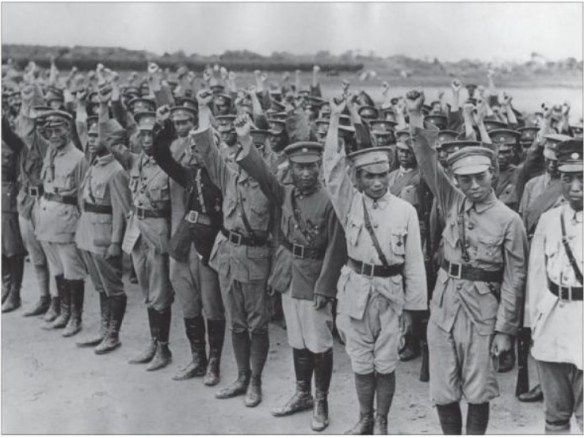Nationalist officers of the victorious NRA, wearing various shades of khaki uniform, cheer their success at a parade in 1929. They would have little time to enjoy their victory over the Ankuochun; revolts against Kuomintang rule continued into 1930, and it is unlikely that many of these young officers would survive the war with the invading Japanese Imperial Army that lasted from 1931 until 1945.
The armed force which supported the Kuomintang Party’s existence in its south-eastern power-base in Canton was originally small and very poorly equipped. Despite the revolutionary pedigree of Sun Yat-sen, his Cantonese military forces were regarded in the early 1920s as just another warlord army, and – like most southern Chinese soldiers – had a poor military reputation. Their transformation began with the arrival of a Soviet military advisory mission in late 1923.
In 1924, Sun Yat-sen set up a new military instruction centre; this Whampoa Academy was to train and indoctrinate highly motivated cadets, who were later to lead the fight to defeat the Northern Warlords from 1926. By 1924 the newly named National Revolutionary Army was 100,000 strong .but had only 65,000 rifles, 370 machine guns and 70 assorted artillery pieces. Small arms were in a bad state, since before the arrival of Soviet supplies most had been ‘begged, borrowed or stolen’. Many soldiers were even armed with ancient matchlocks; it was estimated that 16 per cent of their small arms were obsolete and another 20 per cent totally useless, and Soviet advisors reported the shortfall in rifles to be at least 20,000. Nearly all of the NRA’s artillery was of small calibres – 37mm, 47mm and 57mm, with only a few 75mm guns – and nearly all were obsolete even by Chinese standards. Shortages of weaponry were not exclusive to the NRA, but before 1926 they were particularly poorly equipped. The ratios of crew-served weapons to manpower were only one field gun per 1,000 men and one machine gun per 250.
When the vital Soviet arms supplies began to arrive from 1924 they gradually enabled the RA to prepare for its grandiose planned expedition to defeat the Northern Warlords. Between October 1924 and October 1926 the NRA received from the Soviet Union 157 field guns, 48 mountain guns, 128 mortars, 295 machine guns and no fewer than 74,000 rifles. They also received 24 aircraft, mostly of the RIM 5 type a Soviet copy of the British de Havilland DH-9 two-seat biplane bomber that had proved successful in the last year of the Great War.
When the Northern Expedition was launched in 1926 the 100,000-strong NRA was made up of three armies – the 1st, 2nd and 3rd Route Armies – witl1 the 1st made up of graduates from the Whampoa Academy. Throughout the duration of the Northern Expedition the elite troops from the Whampoa Academy formed the vanguard, but their revolutionary zeal was not matched by some of the other components of the rapidly expanding RA. General Chiang Kai-shek could not hope to defeat the large armies of the Northern Warlords with just a few thousand men, and he had to compromise constantly to expand his forces. The troops of allied warlords could not be expected to have the same dedication to the revolution as the core of the NRA, and heavy casualties amongst the Whampoa graduates in the early fighting in 1926 weakened the most reliable element. The NRA that emerged from the fighting to become the Chinese National (ist) Army after 1928 could never again really be described as a revolutionary army.
